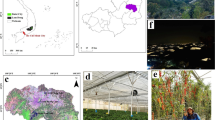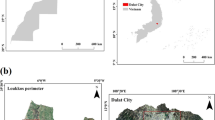Abstract
The extraction of plastic greenhouses (PGH) has been addressed by remote sensing mainly in areas with densely distributed PGH and simple land cover. However, there still remain substantial challenges in extracting the PGH with scattered distribution in some developing agricultural regions. This paper proposed a threshold model to extract the PGH with scattered distribution from Landsat 8 OLI (L8 OLI) images. The threshold model was created by seven discriminative features with the help of an object-based image analysis and spectral analysis. Then, the proposed model was successfully applied to extract the PGH in Xuzhou city of Jiangsu Province, China, a large area of 11,258 km2 with scattered PGH distribution and complex land cover, in 2014 and 2018. A total of 18,000 random points were generated to evaluate the extraction accuracy. The evaluation results show that the overall accuracy was higher than 98%, the producer’s accuracy was over 85%, and the user’s accuracy was over 95%. A visual interpretation with the high-spatial-resolution Google Earth Images also manifests the effectiveness of our results. Meanwhile, the applications in different years demonstrate the temporal consistency of the results. The study indicates that our presented method has large potential to map the PGH in a large spatial scale over a long-term period.

















Similar content being viewed by others
References
Agüera, F., & Liu, J. G. (2009). Automatic greenhouse delineation from QuickBird and Ikonos satellite images. Computers and Electronics in Agriculture,66(2), 191–200.
Aguilar, M. Á., Bianconi, F., Aguilar, F. J., & Fernández, I. (2014). Object-based greenhouse classification from GeoEye-1 and WorldView-2 stereo imagery. Remote Sensing,6(5), 3554–3582.
Antonio, N., & Eufemia, T. (2015). Combining ad hoc spectral indices based on Landsat-8 OLI/TIRS sensor data for the detection of plastic cover vineyard. Remote Sensing Letters,6(12), 933–941.
Benz, U. C., Hofmann, P., Willhauck, G., Lingenfelder, I., & Heynen, M. (2011). Multi-resolution, object-oriented fuzzy analysis of remote sensing data for GIS-ready information. Isprs Journal of Photogrammetry & Remote Sensing,58(3), 239–258.
Carper, W. J., Lillesand, T. M., & Kiefer, P. W. (1990). The use of intensity hue-saturation transformations for merging SPOT panchromatic and multispectral image data. Photogrammetric Engineering and Remote Sensing,56(4), 459–467.
Chen, D. M. (2007). Optimization in multi-scale segmentation of high-resolution satellite images for artificial feature recognition. International Journal of Remote Sensing,28(20), 4625–4644.
Chen, Z., Wang, L., Wu, W., & He, L. (2016). Monitoring plastic-mulched farmland by Landsat-8 OLI imagery using spectral and textural features. Remote Sensing,8(4), 353.
Coslu, M., Sonmez, N. K., & Koc-San, D. (2016). Object-based greenhouse classification from high resolution satellite imagery: A case study Antalya-Turkey. ISPRS: International Archives of the Photogrammetry, Remote Sensing and Spatial Information Sciences,41(B7), 183–187.
Deusen, E. V. (1985). Raster graphics handbook. New York: Van Nostrand Reinhold.
Drăguţ, L., Csillik, O., Eisank, C., & Tiede, D. (2014). Automated parameterisation for multi-scale image segmentation on multiple layers. ISPRS Journal of Photogrammetry and Remote Sensing,88(100), 119–127.
Duro, D. C., Franklin, S. E., & Dubé, M. G. (2012). A comparison of pixel-based and object-based image analysis with selected machine learning algorithms for the classification of agricultural landscapes using SPOT-5 HRG imagery. Remote Sensing of Environment,118(6), 259–272.
Espí, A., SalmerÓn, A., Fontecha, A., García, Y., & Real, A. I. (2006). Plastic films for agricultural applications. Journal of Plastic Film & Sheeting,22(2), 85–102.
Frohn, R. C., Autrey, B. C., Lane, C. R., & Reif, M. (2011). Segmentation and object-oriented classification of wetlands in a karst Florida landscape using multi-season Landsat-7 ETM + imagery. International Journal of Remote Sensing,32(5), 1471–1489.
Gamanya, R., Maeyer, P. D., & Dapper, M. D. (2007). An automated satellite image classification design using object-oriented segmentation algorithms: A move towards standardization. Expert Systems with Applications,32(2), 616–624.
Gao, M., Qunou, J., Yiyang, Z., Wentao, Y., & Mingchang, S. (2018). Comparison of plastic greenhouse extraction method based on GF-2 remote-sensing imagery. Journal of China Agricultural University,23(8), 125–134.
Ingman, M., Santelmann, M. V., & Tilt, B. (2017). Agricultural water conservation in china: plastic mulch and traditional irrigation. Ecosystem Health and Sustainability,1(4), 1–11.
Jing, L. I., Zhao, G. X., Tao, L. I., & Yue, Y. D. (2004). Study on technique of extracting greenhouse vegetable information from Landsat TM Image. Journal of Soil Water Conservation,18(1), 126–129.
Kaut, H., & Singh, R. (1993). A review on image segmentation techniques. Pattern Recognition,26(9), 1277–1294.
Kavzoglu, T., & Yildiz Erdemir, M. (2014). Parameter-based performance analysis of object-based image analysis using Aerial and Quikbird-2 images. In ISPRS annals of the photogrammetry, remote sensing and spatial information sciences, 2014 ISPRS technical commission VII symposium, II-7. https://doi.org/10.5194/isprsannals-ii-7-31-2014.
Koc-San, D. (2013). Evaluation of different classification techniques for the detection of glass and plastic greenhouses from WorldView-2 satellite imagery. Journal of Applied Remote Sensing,7(1), 3553.
Levin, N., Lugassi, R., Ramon, U., Braun, O., & Ben, E. (2007). Remote sensing as a tool for monitoring plasticulture in agricultural landscapes. International Journal of Remote Sensing,28(1), 183–202.
Li, W., Guo, Q., & Elkan, C. (2011). A positive and unlabeled learning algorithm for one-class classification of remote-sensing data. IEEE Transactions on Geoscience and Remote Sensing,49(2), 717–725.
Liu, D., & Xia, F. (2010). Assessing object-based classification: Advantages and limitations. Remote Sensing Letters,1(4), 187–194.
Lu, L., Di, L., & Ye, Y. (2014). A decision-tree classifier for extracting transparent plastic-mulched landcover from Landsat-5 TM images. IEEE Journal of Selected Topics in Applied Earth Observations and Remote Sensing,7(11), 4548–4558.
Lu, L., Hang, D., & Di, L. (2015). Threshold model for detecting transparent plastic-mulched landcover using moderate-resolution imaging spectroradiometer time series data: A case study in southern Xinjiang, China. Journal of Applied Remote Sensing,9(1), 097094.
Ma, Q. (2011). Land use information remote sensing extraction and effects of different land use on soil quality in greenhouse vegetable region. Tai’an: Shandong Agricultural University.
Milton, T. (2001). Book Review: Computer processing of remotely-sensed images. An introduction. Progress in Physical Geography,25(1), 145–146.
Mormile, P., Stahl, N., & Malinconico, M. (2017). The World of Plasticulture. In M. Malinconico (Ed.), Soil degradable bioplastics for a sustainable modern agriculture (pp. 1–21). Milan: Springer.
Munoz-Marf, J., Bruzzone, L., & Camps-Vails, G. (2007). A support vector domain description approach to supervised classification of remote sensing images. IEEE Transactions on Geoscience and Remote Sensing,45(8), 2683–2692.
Myint, S. W., Yuan, M., Cerveny, R. S., & Giri, C. P. (2008). Comparison of remote sensing image processing techniques to identify tornado damage areas from Landsat TM data. Sensors,8(2), 1128–1156.
Neubert, M., Herold, H., & Meinel, G. (2008). Assessing image segmentation quality—Concepts, methods and application. In T. Blaschke, S. Lang, & G. J. Hay (Eds.), Object-based image analysis (pp. 769–784). Berlin: Springer.
Novelli, A., Aguilar, M. A., Nemmaoui, A., Aguilar, F. J., & Tarantino, E. (2016). Performance evaluation of object based greenhouse detection from Sentinel-2 MSI and Landsat 8 OLI data: A case study from Almería (Spain). International Journal of Applied Earth Observations & Geoinformation,52, 403–411.
Picuno, P. (2011). Analysis of plasticulture landscapes in Southern Italy through remote sensing and solid modelling techniques. Landscape & Urban Planning,100(1), 45–56.
Roy, D. P., Wulder, M. A., Loveland, T. R., Woodcock, C. E., Allen, R. G., Anderson, M. C., et al. (2014). Landsat-8: Science and product vision for terrestrial global change research. Remote Sensing of Environment,145(145), 154–172.
Statistics, Xuzhou Municipal Bureau of Statistics. (2018). Xuzhou statistical yearbook. Xuzhou.
Trimble Germany GmbH. (2012). eCognition Developer 8.8 reference book. Munich: Trimble Germany GmbH.
Vieira, M. A., Formaggio, A. R., Rennó, C. D., Atzberger, C., Aguiar, D. A., & Mello, M. P. (2012). Object based image analysis and data mining applied to a remotely sensed Landsat time-series to map sugarcane over large areas. Remote Sensing of Environment,123(8), 553–562.
Wang, J., Hong, Z., Guo, S., Li, S., Sun, J., Wang, J., et al. (2016). Temperature humidity performance and application of solar greenhouse suiting for winter and summer. Transactions of the Chinese Society of Agricultural Engineering,32(23), 190–198.
Witharana, C., Civco, D. L., & Meyer, T. H. (2014). Evaluation of data fusion and image segmentation in earth observation based rapid mapping workflows. ISPRS Journal of Photogrammetry and Remote Sensing,87, 1–18.
Wu, C. F., Deng, J. S., Wang, K., Ma, L. G., & Tahmassebi, A. R. S. (2016). Object-based classification approach for greenhouse mapping using Landsat-8 imagery. International Journal of Agricultural & Biological Engineering,9(1), 79–88.
Yang, X., Feng, Y., & Liu, H. (2006). An object extraction method based on HSI color model. Optical Technique,32(2), 290–292.
Acknowledgments
The authors show great thanks to the website of Geospatial Data Cloud (GSCloud), China, for providing the image data. This work was supported by National Natural Science Foundation of China under Grant (41601405), Jiangsu Provincial Land and Resources Science and Technology Project (2018054), the Fund of Xuzhou Land and Resources Bureau Science and Technology Project (XZGTKJ2018001), the Fund of Xuzhou Science and Technology Key R&D Program (Social Development) Project (KC18139), and the Postgraduate Research and Practice Innovation Program of Jiangsu Province (KYCX18_2156). Special thanks are due to anonymous reviewers for their excellent comments and efforts for the improvement in the manuscript.
Author information
Authors and Affiliations
Corresponding author
Additional information
Publisher's Note
Springer Nature remains neutral with regard to jurisdictional claims in published maps and institutional affiliations.
About this article
Cite this article
Ji, L., Zhang, L., Shen, Y. et al. Object-Based Mapping of Plastic Greenhouses with Scattered Distribution in Complex Land Cover Using Landsat 8 OLI Images: A Case Study in Xuzhou, China. J Indian Soc Remote Sens 48, 287–303 (2020). https://doi.org/10.1007/s12524-019-01081-8
Received:
Accepted:
Published:
Issue Date:
DOI: https://doi.org/10.1007/s12524-019-01081-8




